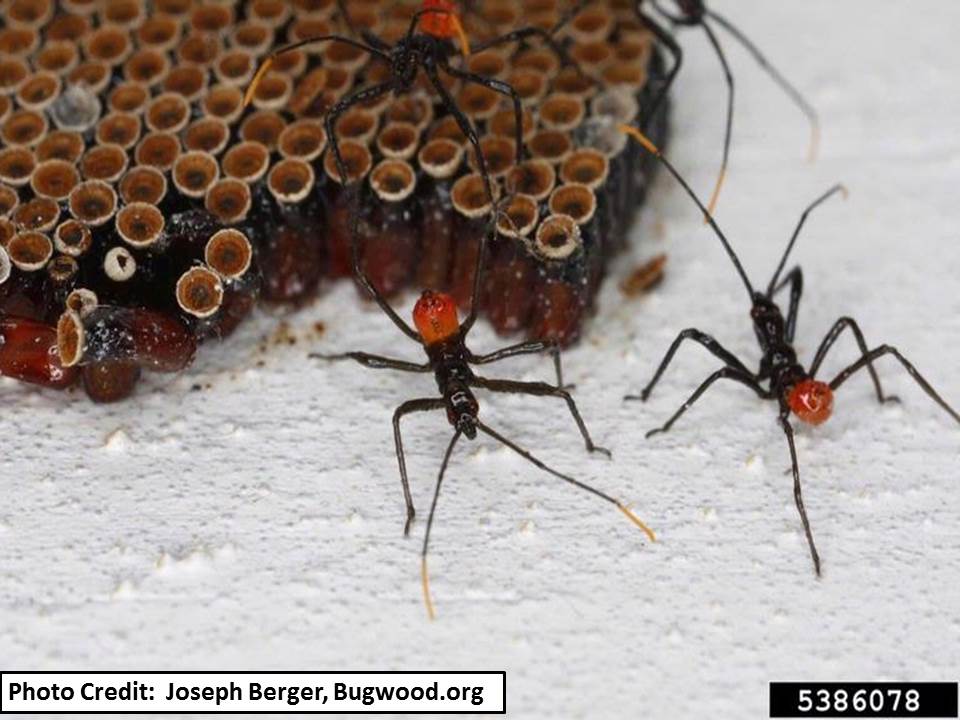–Dr. Bob Bauernfeind
This common musical refrain comes to mind each fall as BIG YELLOWS roar back into action picking up and delivering kiddos to and from school. Another commonly encountered fall harbinger is a large assassin bug which possesses a distinct dorsal thoracic crest: the wheel bug.
Actually, wheel bugs are frequently first noted in the beginning of summer. However, they are not recognized as such due to their radically different appearance. Wheel bug nymphs hatching from overwintered eggs are small, possess a red abdomen which is held in an elevated position, rapidly move about on long “spidery” black legs, and lack the adult’s characteristic “wheel”. Wheel bug nymphs are the basis for reports of “small red biting spiders”.
The proboscis is the “action end” of wheel bugs (both nymphs and adults). Like the earlier described minute pirate bugs, wheel bugs are predators. They use their piercing/sucking mouthpart to pierce through the integument of their prey. During this probing process, they introduce a bit of paralytic saliva which immobilizes their prey as well as aiding in the liquefaction of internal elements which then are withdrawn. Wheel bugs are opportunistic feeders and capable of rapid movement. However, given the slooooow movement of caterpillars which are a known “favorite food” of wheel bugs, speed-of-capture would seem irrelevant.
Despite their reputation for inflicting a painful bite, they can be carefully handled. It should be stated that wheel bugs are not aggressive in the sense of attacking people. If one offers a finger or a hand for a wheel bug to crawl onto, their first tendency is to shy away/hide. However they may choose to lazily climb aboard. Let them wander, and when tired of such, quickly flick them off. Do not grab/hold onto them for that will invite a bite (actually, not a bite/chomp per se, but rather a defensive jab).
Just as a person can safely handle a snapping turtle by properly grasping onto the base of its tail, if one wishes to get a closer look at a wheel bug, while it is on a hard surface, use your index finger and thumb to properly grasp the wheel bug on the sides of its hardened thorax. Use a toothpick or piece of straw to maneuver its proboscis forward, and you may see a small bubble produced at its tip —- this is the saliva which it uses to paralyze its prey (and that which causes the pain/sting on the receiving end of a defensive poke).
Another interesting feature has to do with the female wheel bug. While in your finger-thumb grasp, as an expression of her annoyance, she may react by everting her reddish/orange anal glands which produce a substance with a distinctive odor. This may be a defensive tactic. It has also been suggested that it may act as a repellent offering protection to newly deposited egg masses.
While the wheel bug is the most widely recognized assassin bug, there are many other species.
They vary in size and body shape. While most are rather non-descript and dark-in-color (varying shades of brown or black), others can be brightly colored and patterned. Although most prey upon insects, several species require blood meals for development and egg production. The eastern bloodsucking conenose (Triatoma sanguisuga) is the representative species found in Kansas. Typically feeding on a wide variety of mammalian wildlife, they have been known to also seek a blood meal from humans. People may have heard about “kissing bugs” being responsible for transmitting Chagas Disease. This is of significance in tropical countries where other Triatoma spp. are the major vectors. Thus Kansans can be-at-ease.



